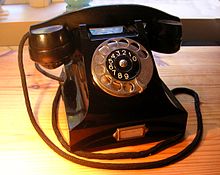Telephone
A telephone, also known as a phone, is a communication tool. People use it to talk with people far away. Originally, it was an electric tool sending analogue speech through wires. Many telephones in the 21st century are electronic tools sending digital signals on wires or radio transmission. Using a telephone, two people who are in different places can talk to each other. Early telephones needed to be connected with wires which are called fixed or landline telephones. Modern mobile phones use radio waves.


History
changeAlexander Graham Bell was the first person to patent the telephone, in 1876.[1] Early telephones were wired directly to each other and could only talk to the phone that they were connected to. Later, telephone exchanges allowed connecting to other telephones. During the 20th century the machines that made the connections were automated.
Types of telephones
changeThere are many different types of telephones. A telephone that can be carried around is called a mobile phone or cell phone. These became popular in the 1980s. It has become common for people to carry mobile phones and in many places it is unusual to not have one. The majority are smartphones, which can be used as computers. Some mobile phones can make telephone calls using communications satellites instead of masts on the ground, which means people can make calls from anywhere in the world.
In most countries there were public payphones. To use one, people paid with coins, a credit card or a prepaid card.
Computers can use a machine called a modem or a Digital subscriber line router to talk to other computers over a telephone line. This allows a computer to connect to other computer networks including the Internet.
Most countries have a telephone network. The telephones in one place are connected to a telephone exchange. The exchanges are connected together in a world-wide network. In developing countries cell phones are used as a cheaper and faster way to connect the countryside to the network.
Telephone number
changeMost telephones have their own number. Today, telephone numbers are about seven to ten digits long. In many countries, part of the telephone number is called the area code. Area codes are used to make sure the numbers are not the same in two different places. Areas have their own area code, and countries have their own country code.
Usage
changeBy the end of 2009, there were nearly 6 billion mobile and fixed-line telephone subscribers worldwide. This included 1.26 billion fixed-line subscribers and 4.6 billion mobile subscribers.[2]
References
change- ↑ "Alexander Graham Bell Laboratory Notebook, 1875-1876". World Digital Library. 1875–1876. Retrieved 2013-07-24.
- ↑ Next-Generation Networks Set to Transform Communications, International Telecommunications Union website, 4 September 2007. Retrieved 5 July 2009.